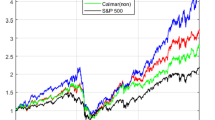Abstract
The copula theory allows to easily model the probability distributions of random vectors by separately estimating the marginal distributions and the dependence structure of the components represented by the copula itself. Copula functions generally provide significant improvements to the financial portfolio allocation problem. However, being given the large spectrum of available copulas, the choice of the best model is rather complex. This paper investigates the copula misspecification impact on the portfolio allocation problem, which is an important risk model issue. We address this issue from the perspective of the behavioral portfolio theory through the Zakamouline (Quant Finance 14(4):699–710, 2014) approach by considering an investor allocating his wealth between a risk-free asset and a risky asset. Our main objective is to assess investors’ sensitivities to the choice of the probability of the random vector, namely both the marginal distributions and the copula function. This analysis is conducted with respect to their degrees of risk and loss aversions, for different compositions of the risky asset, and for different investment horizons.





Similar content being viewed by others
Notes
For this numerical case, we can also consider alternatively other copulas than the Student to define the “true” copula. We recover same qualitative results. In the empirical part, it is the Rotated Clayton that fits data better than the other ones (see goodness-of-fit tests) and thus is chosen as the “true” copula.
Further generalizations are straightforward but very time consuming from the numerical point of view.
Except for an investor with preferences of types \(\left( \alpha =0.1;\beta =0.8\right) \).
For more details see Patton (2012).
References
Agarwal, V., & Naik, N. Y. (2004). Risks and portfolio decisions involving hedge funds. Review of Financial Studies, 17(1), 63–98.
Ayub, U., Shah, S. Z. A., & Abbas, Q. (2015). Robust analysis for downside risk in portfolio management for a volatile stock market. Economic Modelling, 44, 86–96.
Benartzi, S., & Thaler, R. H. (1995). Myopic loss aversion and the equity premium puzzle. The Quarterly Journal of Economics, 110(1), 73–92.
Bertrand, P., & Prigent, J. L. (2011). Omega performance measure and portfolio insurance. Journal of Banking and Finance, 35(7), 1811–1823.
Bollerslev, T. (2010). Glossary to ARCH (GARCH). In T. Bollerslev, J. Russell, & M. Watson (Eds.), volatility and time series econometrics: Essays in honor of Robert Engle. Oxford: Oxford University Press.
Bollerslev, T., Engle, R. F., & Nelson, D. B. (1994). ARCH models. Handbook of Econometrics, 4, 2959–3038.
Cass, D., & Stiglitz, J. (1970). The structure of investor preferences and asset returns, and separability in portfolio allocation. Journal of Economic Theory, 2, 122–160.
de Palma, A., & Prigent, J.-L. (2009). Standardized versus customized portfolio: A compensating variation approach. Annals of Operations Research, 165(1), 161–185.
Di Clemente, A., & Romano, C. (2004). Measuring and optimizing portfolio credit risk: A copula-based approach. Economic Notes, 33(3), 325–357.
Diks, C., Panchenko, V., & Van Dijk, D. (2010). Out-of-sample comparison of copula specifications in multivariate density forecasts. Journal of Economic Dynamics and Control, 34(9), 1596–1609.
Embrechts, P., Lindskog, F., & McNeil, A. J. (2003). Modelling dependence with copulas and applications to risk management. In S. T. Rachev (Ed.), Handbook of heavy tailed distributions in finance. Amsterdam: Elsevier.
Fantazzini, D. (2008). Dynamic copula modelling for value at risk. Frontiers in Finance and Economics, 5(2), 72–108.
Favre, L., & Galeano, J. A. (2002). Mean-modified value-at-risk optimization with hedge funds. The Journal of Alternative Investments, 5(2), 21–25.
Genest, C., Rémillard, B., & Beaudoin, D. (2009). Goodness-of-fit tests for copulas: A review and a power study. Insurance: Mathematics and Economics, 44(2), 199–213.
Gilli, M., & Schumann, E. (2010). Distributed optimization of a portfolio’s Omega. Parallel Computing, 36(7), 381–389.
Gollier, C. (2001). The economics of risk and time. Cambridge, MA: The MIT Press.
Hansen, B. E. (1994). Autoregressive conditional density estimation. International Economic Review, 35(3), 705–730.
Huang, C., & Litzenberger, R. H. (1988). Foundations for financial economics. New York: North-Holland.
Joe, H. (1997). Multivariate models and dependence concepts. London: Chapman & Hall.
Jurczenko, E., & Maillet, B. B. (2006). Multi-moment asset allocation and pricing models. New York: Wiley Finance, Wiley.
Markowitz, H. (1952). Portfolio selection. Journal of Finance, 7(1), 77–91.
Nelsen, R. B. (2006). An introduction to copulas (Springer series in statistics). New York: Springer.
Ogryczak, W. (2000). Multiple criteria linear programming model for portfolio selection. Annals of Operations Research, 97, 143–162.
Patton, A. J. (2004). On the out-of-sample importance of skewness and asymmetric dependence for asset allocation. Journal of Financial Economics, 2, 130–168.
Patton, A. J. (2006). Modelling asymmetric exchange rate dependence. International Economic Review, 47(2), 527–556.
Patton, A. J. (2012). A review of copula models for economic time series. Journal of Multivariate Analysis, 110, 4–18.
Popova, I., Popova, E., Morton, D., & Yau, J. (2007). Optimizing benchmark-based portfolios with hedge funds. The Journal of Alternative Investments, 10, 35–55.
Riccetti, L. (2013). A copula-GARCH model for macro asset allocation of a portfolio with commodities. Empirical Economics, 44(3), 1315–1336.
Rockafellar, R. T., & Uryasev, S. (2000). Optimization of conditional value-at-risk. Journal of Risk, 2, 21–42.
Sklar, A. (1959). Fonctions de répartition à n dimensions et leurs marges. Publ. Inst. Statist. Univ. Paris, 8, 229–231.
Tversky, A., & Kahneman, D. (1992). Advances in prospect theory: Cumulative representation of uncertainty. Journal of Risk and Uncertainty, 5, 297–323.
Zakamouline, V. (2014). Portfolio performance evaluation with loss aversion. Quantitative Finance, 14(4), 699–710.
Author information
Authors and Affiliations
Corresponding author
Appendix
Appendix
Rights and permissions
About this article
Cite this article
Saida, A.B., Prigent, Jl. On the robustness of portfolio allocation under copula misspecification. Ann Oper Res 262, 631–652 (2018). https://doi.org/10.1007/s10479-016-2137-0
Published:
Issue Date:
DOI: https://doi.org/10.1007/s10479-016-2137-0




